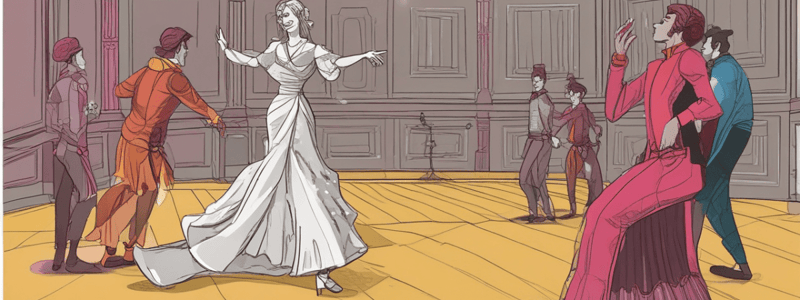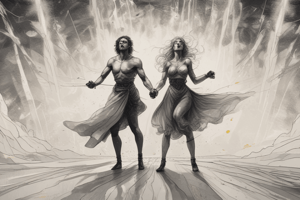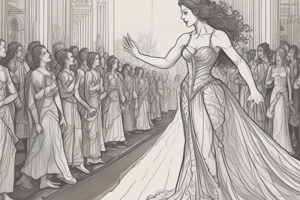Podcast
Questions and Answers
What is the primary focus of Module 5 in the course?
What is the primary focus of Module 5 in the course?
What is the core principle of Method Acting?
What is the core principle of Method Acting?
Who developed the Meisner Technique?
Who developed the Meisner Technique?
What is the primary goal of the Meisner Technique?
What is the primary goal of the Meisner Technique?
Signup and view all the answers
What is the name of the technique developed by David Mamet and William H. Macy?
What is the name of the technique developed by David Mamet and William H. Macy?
Signup and view all the answers
What does Practical Aesthetics aim to achieve?
What does Practical Aesthetics aim to achieve?
Signup and view all the answers
What is a key aspect of Practical Aesthetics?
What is a key aspect of Practical Aesthetics?
Signup and view all the answers
What is a common goal of contemporary acting techniques?
What is a common goal of contemporary acting techniques?
Signup and view all the answers
What is the primary focus of the Viewpoints technique?
What is the primary focus of the Viewpoints technique?
Signup and view all the answers
What is a key element of Clowning in theater?
What is a key element of Clowning in theater?
Signup and view all the answers
What is the result of combining Experimental and Physical Theater?
What is the result of combining Experimental and Physical Theater?
Signup and view all the answers
What is Devising in the context of Experimental and Physical Theater?
What is Devising in the context of Experimental and Physical Theater?
Signup and view all the answers
Why is spatial awareness important in Experimental and Physical Theater?
Why is spatial awareness important in Experimental and Physical Theater?
Signup and view all the answers
What is essential for performers to convey in Experimental and Physical Theater?
What is essential for performers to convey in Experimental and Physical Theater?
Signup and view all the answers
What is the benefit of integrating Experimental and Physical Theater?
What is the benefit of integrating Experimental and Physical Theater?
Signup and view all the answers
What is encouraged in Experimental and Physical Theater?
What is encouraged in Experimental and Physical Theater?
Signup and view all the answers
What is the primary focus of the Viewpoints technique?
What is the primary focus of the Viewpoints technique?
Signup and view all the answers
Who developed the Suzuki Method?
Who developed the Suzuki Method?
Signup and view all the answers
What is the primary focus of the Michael Chekhov Technique?
What is the primary focus of the Michael Chekhov Technique?
Signup and view all the answers
What is the primary characteristic of post-modernism?
What is the primary characteristic of post-modernism?
Signup and view all the answers
What is deconstructionism?
What is deconstructionism?
Signup and view all the answers
What is intertextuality?
What is intertextuality?
Signup and view all the answers
What is metafiction?
What is metafiction?
Signup and view all the answers
What is fragmentation?
What is fragmentation?
Signup and view all the answers
What is the primary purpose of parody and pastiche?
What is the primary purpose of parody and pastiche?
Signup and view all the answers
Which technique is focused on training the actor's body to achieve precision, strength, and control?
Which technique is focused on training the actor's body to achieve precision, strength, and control?
Signup and view all the answers
What is the primary difference between parody and pastiche?
What is the primary difference between parody and pastiche?
Signup and view all the answers
What is a key concept of post-modernism's approach to hybridity and border-crossing?
What is a key concept of post-modernism's approach to hybridity and border-crossing?
Signup and view all the answers
What is the primary goal of post-modernism's subversion of hierarchies?
What is the primary goal of post-modernism's subversion of hierarchies?
Signup and view all the answers
What is the primary focus of physical theater?
What is the primary focus of physical theater?
Signup and view all the answers
What is a key characteristic of experimental theater?
What is a key characteristic of experimental theater?
Signup and view all the answers
What is the primary goal of the 'death of the author' concept?
What is the primary goal of the 'death of the author' concept?
Signup and view all the answers
What is a key element of avant-garde techniques in experimental theater?
What is a key element of avant-garde techniques in experimental theater?
Signup and view all the answers
What is the primary role of mime in physical theater?
What is the primary role of mime in physical theater?
Signup and view all the answers
What is a key concept of post-modernism's approach to meaning and interpretation?
What is a key concept of post-modernism's approach to meaning and interpretation?
Signup and view all the answers
What is the primary goal of exploring experimental and physical theater in Module 5?
What is the primary goal of exploring experimental and physical theater in Module 5?
Signup and view all the answers
Study Notes
Contemporary Acting Techniques
- Method Acting: requires actors to immerse themselves in the character, personally experiencing thoughts, emotions, and physicality to create realistic performances.
- Meisner Technique: emphasizes truthful and spontaneous responses, focusing on listening to fellow actors and reacting in the moment, rather than pre-planning actions and lines.
- Practical Aesthetics: strips away unnecessary elements to reveal the essence of the performance, focusing on specific actions, objectives, and pursuits of truth in every moment.
- Viewpoints: emphasizes physicality, creating awareness of time and space, and exploring the relationship between actors and their environment.
- Suzuki Method: focuses on training the actor's body to achieve precision, strength, and control, integrating traditional Japanese techniques with contemporary practices.
- Michael Chekhov Technique: explores the use of imagination, emphasizing the actor's inner life and creative imagination to bring depth and richness to performances.
Post-Modern Approaches
- Deconstructionism: challenges the assumption that a text or artwork has a fixed and stable meaning, revealing underlying contradictions and multiple interpretations.
- Intertextuality: recognizes that all texts are interconnected and influenced by other texts, creating meaning through juxtaposition and combination.
- Metafiction: blurs the boundaries between fiction and reality, incorporating self-reflexive elements and undermining traditional storytelling conventions.
- Fragmentation: disrupts traditional narrative structures, presenting texts or artworks in non-chronological order or in fragments.
- Parody and Pastiche: satirize or emulate existing works or genres, challenging the idea of originality and questioning cultural hierarchies.
- Hybridity and Border-crossing: mixes elements from different traditions, cultures, and genres, promoting a fluid and dynamic understanding of identity.
- The Death of the Author: challenges the traditional notion of the author as the sole authority over interpretation, emphasizing the role of the reader or viewer in co-creating meaning.
Experimental and Physical Theater
- Experimental Theater:
- Challenges traditional theatrical conventions
- Employs non-linear narratives and avant-garde techniques
- Encourages innovation and risk-taking
- Physical Theater:
- Emphasizes non-verbal communication, bodily expression, and movement
- Integrates elements from mime, dance, acrobatics, and clowning
- Demands performers to be highly expressive and skilled in physicality
- Key Techniques:
- Mime: silent storytelling using physical gestures and expressions
- Viewpoints: focuses on physical exploration of space, time, and movement
- Clowning: exaggerated physical comedy, improvisation, and audience interaction
- Integrating Experimental and Physical Theater:
- Devising: collaborative creation of original material by performers
- Spatial Awareness: understanding and creatively utilizing performance space
- Emotional Authenticity: connecting with emotions and conveying them truthfully through physical expressions
Studying That Suits You
Use AI to generate personalized quizzes and flashcards to suit your learning preferences.
Description
Explore contemporary acting techniques in modern-day acting, excluding post-modern and experimental approaches. Learn about the methodology and practices of contemporary acting.




